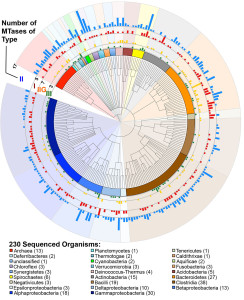Single-molecule sequencing technology assists microbial DNA methylation study.
The Science
Researchers sequenced 230 diverse archaeal and bacterial genomes to learn more about the roles DNA methylation plays in prokaryotes.

Phylogenetic tree of 230 sequenced organisms. Outer bars indicate the number and types of active MTases detected per genome. (Fig. 1A from Blow et al. (2016) Plos Gen.)
The Impact
The epigenome of a cell is the collected set of changes made to specific bases in its genomic DNA that affect how the genome is actually used and results from chemical modification (usually methylation.) Uncovering the breadth of the planet’s microbial epigenomic diversity can help researchers better understand the biology of microbes that play a role in the global nutrient cycles, as well as revealing genomic regulatory systems that could be useful for energy and environment applications.
Summary
DNA methylation, the most common epigenetic change, is a process eukaryotes use to regulate gene expression, for example, keeping certain genes from turning on. Though prokaryotes (bacteria and archaea) are also known to have methylated DNA, the roles this process might play in these single cell organisms is less well understood. To learn more, a team including researchers at the U.S. Department of Energy Joint Genome Institute (DOE JGI), a DOE Office of Science User Facility, relied on single-molecule, real-time (SMRT) sequencing at the DOE JGI and Pacific Biosciences to reveal DNA methylation patterns in 230 bacterial and archaeal genomes. They found evidence of DNA methylation in 215 microbes (93 percent of those sequenced). These data enabled the annotation of 600 enzymes that methylate DNA (MTases), a massive increase over known annotations. While many DNA methylating enzymes are part of restriction modification systems, consistent with their known role in defense against phages and viruses, the findings suggest that a substantial number of others may be involved in genome regulation, and have a more crucial role in prokaryotic physiology and biology than had been previously suspected. By mapping and characterizing the epigenetic changes, scientists can associate those targeted genes with environmental adaptations and metabolic activities. Better understanding of such controls on gene expression and under what circumstances they are observed will improve the ability to predict when and where such microbes are detected. In addition, this will inform how microbes interact with plants and other microbes involved in DOE mission interests such as plant bioenergy feedstock growth, advanced biofuel generation, and soil carbon processing. The report was published February 12, 2016 in Plos Genetics and was highlighted February 29, 2016 in Nature Genetics Reviews.
Contacts
Daniel Drell, Ph.D.
Program Manager
Biological Systems Sciences Division
Office of Biological and Environmental Research
Office of Science
US Department of Energy
[email protected]
Matt Blow
DOE Joint Genome Institute
[email protected]
Funding
- DOE Office of Science
- NIH Small Business Innovation Research Program
Publications
- Blow MJ et al. The Epigenomic Landscape of Prokaryotes. PLoS Genet. 12(2):e1005854 (2016). doi: 10.1371/journal.pgen.1005854. eCollection 2016 Feb.